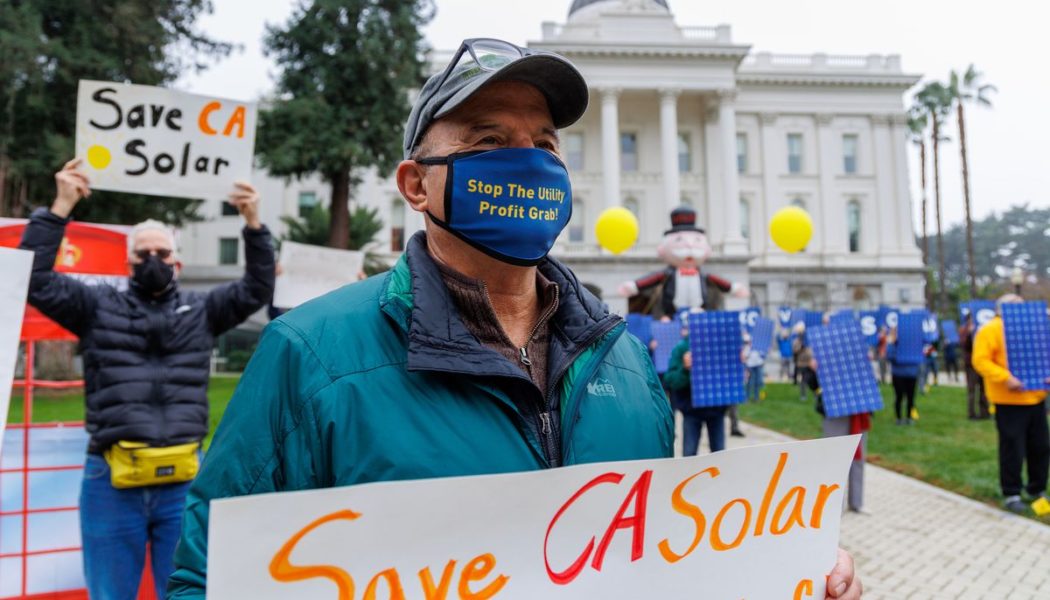California could soon end the perks it has been giving to residents with rooftop solar on their homes, even as it pledges to move entirely to clean electricity. While the move might seem counterintuitive, environmental advocates are divided on whether the changes will help the state meet its climate goals and benefit lower-income residents or harm both efforts.
They’re split on a proposal made last month by the California Public Utilities Commission (CPUC) that would slash solar incentives for customers of investor-owned utilities, implement a new monthly fee to connect solar customers to the grid, and create a $600 million fund to help underrepresented communities gain access to solar panels and batteries. Industry and some conservation groups say the changes would end California’s solar boom. Tesla recently went so far as to send its employees talking points on how to fight back against the proposal. But other environmental and consumer advocates support the proposal and say California needs to do things differently to help lower-income residents who haven’t received as many benefits from rooftop solar to date.
California has more homes with rooftop PV panels than any other state. That’s thanks in part to a history of generous incentives for people with home solar systems. If someone doesn’t use up all the solar energy their panels collect, they can sell it back to the grid. Under the state’s “net metering” program, they can sell it at the same retail rate at which they would buy electricity. The program is supposed to help people recoup the costs of installing their solar system. But if the CPUC ultimately votes to approve its new proposal, the selling price would drop dramatically to better reflect the commission’s estimates of what that energy is actually worth.
That has solar industry folks freaking out. “People are almost in tears, you know, like grown men that built their whole life around their business and their company,” says Bernadette Del Chiaro, executive director of the California Solar & Storage Association. Her group is one out of about 600 organizations that have put together a coalition to stop the CPUC’s proposal.
Opponents of the proposal worry that if people don’t earn as much by selling energy back to the grid, they won’t be able to recoup the tens of thousands of dollars they might have spent installing the system. While the CPUC thinks solar customers could recoup those costs within ten years, critics say the new proposal would greatly stretch out the amount of time it would take to do so. On top of that, the CPUC wants to impose a new monthly “grid participation charge” of $8 per kW that could come out to several hundred dollars a year, to go toward maintaining the grid.
:no_upscale()/cdn.vox-cdn.com/uploads/chorus_asset/file/23153217/1237104239.jpg)
Cost is already a big barrier for middle and lower-income people who might otherwise be interested in solar panels. And critics of the CPUC’s proposal say their plan makes things much worse — putting solar even more out of reach for middle and lower-income households. “It would devastate any efforts to increase equity and inclusion that would make solar for everybody,” says Del Chiaro.
The CPUC, on the other hand, says that the net metering program “disproportionately harms low-income ratepayers” and “negatively impacts” customers without rooftop solar. It, and proponents of its new proposal, say the policy shift will keep electricity rates lower for people without home solar systems.
Today, utilities are charging more for electricity across the board to pay for net metering. That’s because the rates that early solar adopters earned from selling energy back to the grid are up to six times higher than its actual value, according to the CPUC and environmental group Natural Resources Defense Council (NRDC). They estimate that the actual value to the grid is about 5 cents per kW. But someone with a home solar system might earn 30 cents per kW because they’re selling it at the retail rate, which is higher because it includes costs like maintaining the grid.
To make that money back, utilities drive up electricity rates, including for people who don’t own solar panels. Non-solar customers pay between $60 to $200 more on their bills each year as a result, according to one analysis.
One in three Americans already struggles to pay their electricity bills. And consumer advocates who support the CPUC proposal don’t want the net metering program to exacerbate the problem. “Greening the grid should not be cutting off vulnerable communities because the bills are too damn high,” says Mark Toney, executive director of the consumer advocacy group The Utility Reform Network (TURN). “Our thing is we want the most green for the least green.”
The NRDC supports the CPUC’s decision to slash net metering payouts because it says keeping electricity as cheap as possible is crucial to transitioning the economy over to renewable energy. Experts see electrification as key to weaning cars and homes off oil and gas. But that’ll only happen if electricity is affordable in the first place.
“The first priority really is clean, affordable power for everyone,” says Mohit Chhabra, a senior scientist at NRDC. Home solar systems aren’t the only way to achieve that, he points out. It might come from more utility-scale solar and wind farms. “Everybody needs to be able to pay their bills, meet their energy needs — it needs to be clean and pollution free [energy] — and then figure out where rooftop solar belongs in that mix,” he says.
Del Chiaro’s coalition of opponents disputes the CPUC’s estimates of how much utilities are overpaying solar customers through net metering. These groups say that utilities are already charging customers too much for things like wildfire liability and building out more power lines, and that the CPUC’s proposal reflects another money grab.
All the stakeholders — even though they disagree on what should happen to net metering — say they want to see more equitable access to home solar systems, especially for neighborhoods that have been disproportionately saddled with the pollution from fossil fuels. Net metering as it’s currently structured “has not enabled rooftop solar to adequately penetrate” those communities, the California Environmental Justice Alliance, a key group that represents those communities, said in a statement last year.
A small percentage of low income households that qualify for assistance on their bill have rooftop solar and participate in net metering. But Toney says that they got an unfair deal under the old program. Since they qualify for up to a 35 percent discount on their electricity bills, and net metering pays people based on how much they pay for electricity, they also earned 35 percent less than other households in the program. That’s no longer a problem under the CPUC’s new proposal. Del Chiaro agrees that it was a problem that needed to be fixed, but says that it can be addressed without making the other drastic changes CPUC has proposed.
The California Environmental Justice Alliance has yet to weigh in on the CPUC’s new proposal, but some of its recommendations for improving equity seemingly make it into the CPUC’s proposal. For one, the monthly grid participation charge won’t apply to low-income and tribal households. Low-income households and buildings under certain affordable housing programs would also be able to stay on their current net metering program for now, while the program would be phased out for other existing customers in 15 years. To make the shift easier for new solar customers, the proposal includes a Market Transition Credit of up to $5.25 per kW for people who sign up within four years, which would then be applied for the next ten years.
Del Chiaro says the exemptions still don’t cover everyone who might struggle more to pay for rooftop solar under the CPUC’s new plan. That includes low and moderate income households and apartment buildings that don’t qualify for financial assistance. The CPUC says that if its proposal is implemented, it will evaluate the program’s impact on equity over five years and determine if it needs to broaden eligibility requirements for financial assistance or make other changes.
For low-income residents, the up-front installation cost of solar panels also presents a major barrier. The CPUC’s proposal creates a $600 million fund to improve access to solar panels and batteries in low-income communities, which could help them get over that hurdle. Details of how the fund will be set up are still in the works, but that money could potentially come from adding an extra charge to solar customers who are not enrolled in financial assistance programs.
The CPUC proposal also includes rebates for existing solar customers who pair their panels with batteries and transition off the old net metering program over the next four years. Encouraging solar customers to buy batteries is supposed to help reduce pressure on the grid whenever it’s at peak demand — which is usually in the evenings when people come home from work and when the sun is no longer shining. Batteries can also help keep the lights on at home if people lose power due to bad weather, which has been happening more often in California because of the risk of power lines sparking wildfires when conditions are hot, dry, and windy.
But the California Solar and Storage Association, which represents businesses that sell solar panels and batteries, thinks the CPUC’s plan will backfire. Making it more expensive to have a solar system at home will only be a disincentive for people wanting to install panels or batteries, Del Chiaro says. Still, not all future homeowners will have a choice: in 2020, a state mandate kicked in that requires newly constructed homes to include solar panels.
While there’s still a long way to go to close disparities in solar access, Del Chiaro points to data showing that in recent years, solar adoption has grown more quickly in lower income brackets than in higher income brackets. That’s the trend she wants to keep going, which might lead to a legal battle if the CPUC ultimately votes to approve its proposal. That vote could happen as soon as January 27th, after a period for the public to give their comments — which are flowing into the CPUC website with fervor from nervous solar customers.









